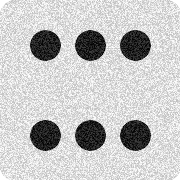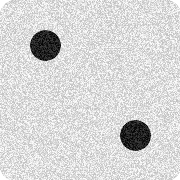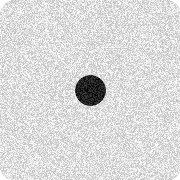Special Ops
Erik Brisson
There are 3 columns of dice. Each die, visually, is a composite of the black pips and uniform noise.
Keep the dice in the center column fixed. Permute the dice in the left column, and permute the dice in the right column. With the correct permutations, in each row, the noise component of adjacent pairs of die images will form random dot stereogram pairs, each giving one arithmetic operation (+, -, X, or /). (These operations can be seen visually even with the pips, and can also be seen by taking the pixel-wise difference of the image pairs). So, within any row, the left and center die will produce one operation symbol, and the center and right die will produce another operation symbol.
For instance, the properly permuted top row will look like this:
 |
 |
 |
Letting your eye stare directions diverge, you can fuse the adjacent images as stereograms, and the operator symbol will appear. Or you can use an image processing command, such as ImageMagick's "compare" operator, which will give you these images:
| compare im_30.png im_01.png | compare im_01.png im_62.png |
 |
 |
Each such comparison will give an operator "between" to adjacent dice, in the example above, 6 - 2 - 1. All together, one will get this:
6 - 2 - 1 3 x 4 + 3 5 x 6 - 4 6 / 3 + 3 2 + 2 x 6 3 x 4 - 3 3 x 6 - 4 6 + 2 / 2
Evaluating the above expression in MDAS order, and taking the resulting value as an index into the alphabet gives the answer:
C = 3 = (6 - 2) - 1 O = 15 = (3 x 4) + 3 Z = 26 = (5 x 6) - 4 E = 5 = (6 / 3) + 3 N = 14 = 2 + (2 x 6) I = 9 = (3 x 4) - 3 N = 14 = (3 x 6) - 4 G = 7 = 6 + (2 / 2)
The final answer is COZENING.
